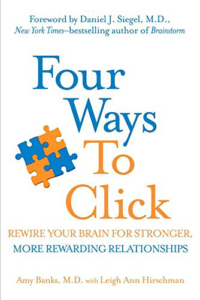
If I were to pick a single “best book” to recommend to those looking for thoughtful, beautifully written advice for improving their lives, I would suggest Four Ways to Click by Dr. Amy Banks (written with Leigh Ann Hirschman). Rarely have I read such an insightful book.
Most people have various issues in “clicking” with others. Think of the times you’ve walked into a party hiding a gnawing feeling of nervousness, or misread people and reacted inappropriately, or simply cut yourself off from others to prevent a bit of heartache. Amy Banks—a medical doctor who specializes in understanding the neurobiology of relationships—explains that our underlying neural circuitry plays a key role in our interactions with others. In fact, our relationships “live” in the neural pathways of our brains and bodies. Variations in our circuitry—sometimes caused by our upbringing and previous interactions, and sometimes by nature itself—can impact our ability to enjoy being with others. The problem is that we humans are designed to find pleasure in social interactions. When we cut ourselves off from those interactions, we can inadvertently set ourselves up to search for pleasure in other, often less salubrious activities—drinking, drugs, overeating, gambling. Or we may lose sight of pleasure altogether and fall into depression.

The good news is that new research in neuroplasticity shows that our brains can be rewired at any age to create more rewarding relationships. Dr. Banks, who has taught psychiatry at Harvard Medical School, provides practical insight not only into why we sometimes cut ourselves off from others, but how we can get back on track in enjoyably bringing others into our lives. As a foundation to help us understand key aspects of the underlying neurocircuitry, she outlines four neural systems—those related to feeling calm around others (via the smart vagus nerve), feeling accepted by others (related to the dorsal anterior cingulate cortex), resonating with the inner states of others (related to the mirroring system), and being energized by others (a consequence of the dopamine reward pathway). These abbreviate to CARE—an easy mnemonic to help us remember the four components of a mental toolkit for “clicking” with others.
One of the great aspects of this book is its beautiful writing and use of evocative imagery to help convey important ideas. For example, this passage gives a sense of how our neural circuitry can go awry:
“One of our recent winters in New England was a bear, with more snowstorms than I can remember since my childhood in Maine. During the third major snowstorm in a single week, my friend’s car became stuck at the end of our driveway, the back two wheels spinning helplessly on a patch of ice. Each time she stepped on the gas pedal, my friend’s wheels spun faster and faster. The pathway transformed from a slick of ice atop the snow’s surface to a deepening icy groove. The more she revved the engine, the deeper the car went, and the more stuck it became. This is what happens with habits and relational patterns. They may start as a small nuisance, but as the action is repeated over and over again, the neural pathway bulks up. The habit becomes entrenched.”
Dr. Banks goes on to describe how she put sand down to help create a new pathway for her friend—and how equivalent new neural pathways can be created by wiring together feelings of pleasure combined with imagery of the behavior you would like to encourage.
Dr. Banks’ remarkably insightful book is a treasure for the legions of people—some of whom may appear from the outside to have successful and healthy relationships—who suffer from social disconnection in their lives. If you would like new insights into how to enjoy life to its fullest, read this book.
Click here to see Rose’s tips for healthy and happy relationships

2 Comments
Shangri-l@
Thank you Barbara for your recommendation – have just ordered a copy !
P. Sinclair
Given that Amy Banks’ powerful and important work strongly emphasizes Relational Cultural Theory (a theory that helped blow out of the water the good ol’ boy network of male dominated views of human psychology and psychotherapy practices), I’m surprised that the images presented here portray only men (or at least seemingly male expression of identity) connecting. We, all of us, must be more aware and vigilant of hidden bias because others will not do this work for us.